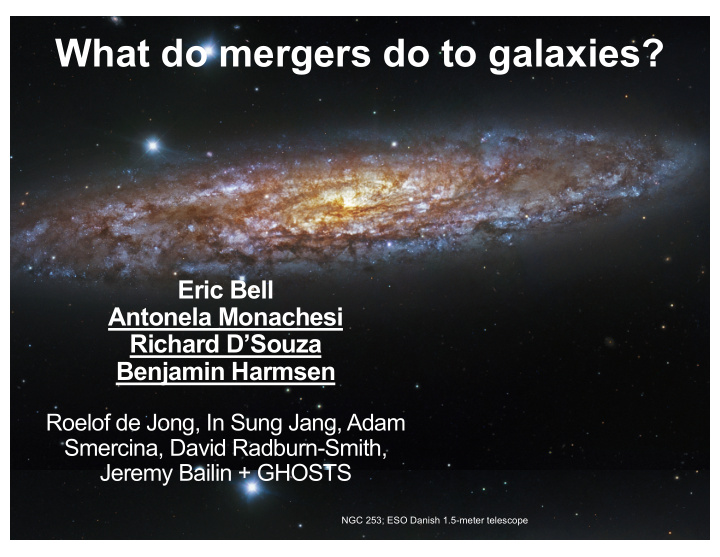



What do mergers do to galaxies? Eric Bell Antonela Monachesi Richard D’Souza Benjamin Harmsen Roelof de Jong, In Sung Jang, Adam Smercina, David Radburn-Smith, Jeremy Bailin + GHOSTS NGC 253; ESO Danish 1.5-meter telescope
Galaxies with masses like the Milky Way have a wide range of structures, star formation histories and gas content Blanton & Moustakas 2009
The merger and accretion history of a galaxy is predicted to be a key driver of its properties Springel et al.
Stellar halos hold the promise to be visible, collisionless tracers of merging and accretion Eris; hydrodynamical model Pillepich et al. 2015
Observational and theoretical challenges have prevented the use of stellar halos as quantitative measures of merger history Bullock and Johnston 2005 Rogelio Bernal Andreo Halos are hard to detect and quantify Eris; hydrodynamical model Pillepich et al. 2015 What are we measuring – Accretion or in situ? How do I disentangle contributions from many satellites?
These challenges have been circumvented and allow us to use stellar halos to quantitatively measure the most massive accretion Illustris hydrodynamical model D’Souza & Bell 2018 Bell et al. 2017 HST/GHOSTS
In MW-mass galaxies models predict that the minor axis at large distance is often accretion-dominated For similar results from the Eris; hydrodynamical model Auriga hydrodynamical model; Pillepich et al. 2015 See also Monachesi et al. 2016, 2018
To learn more we compare minor axis observations with model accreted and in situ stars For similar results from the Eris; hydrodynamical model Auriga hydrodynamical model; Pillepich et al. 2015 See also Monachesi et al. 2016, 2018
Accretion predictions along the minor axis agree with observations, while in situ halos vary but are often over-predicted. Illustris: D’Souza & Bell 2018 For similar results from the Auriga hydrodynamical model; Recall Monachesi’s talk and Monachesi et al. 2016, 2018
Halos including in situ stars appear to have excessive stellar masses and high metallicities Harmsen, et al. 2017; D’Souza & Bell 2018; Monachesi et al. 2018
Observations agree with both accretion only models and accreted part of hydro models Harmsen, et al. 2017; D’Souza & Bell 2018; Monachesi et al. 2018
Accreted halos rely only on merger trees, halo occupation and realistic satellites, so are robust Lacey & Cole 1993 Moster et al. 2013; Behroozi et al. 2013
It is good that in situ predictions disagree. They are sensitive to different physics that we want to understand – e.g., early star formation and assembly, SF at low densities. HST NASA/ESA; Traci Johnson & Keren Sharon
The agreement between minor axis observations and accreted halo predictions strongly suggests that such observations faithfully trace accreted stars Harmsen, Monachesi, Bell et al. 2017
Most accreted halos are predicted to have had a single dominant accretion, much larger than the others While many dark matter halos are accreted, the larger halos have much Cooper et al. 2010 higher stellar mass D’Souza & Bell 2018 and dominate Moster et al. 2013; Behroozi et al. 2013
Because of the galaxy metallicity-mass relationship, the most massive satellite imprints a stellar halo mass-metallicity relation Harmsen, Monachesi, Bell et al. 2017 D’Souza & Bell 2018 Monachesi et al. 2018 The most massive satellite dominates mass and drives up metallicity of accreted halos This is an iron-clad prediction of hierarchical galaxy growth – halos reflect most massive accretion
Models quantify the relationship between dominant accretion event and halo properties… Bell et al. 2017, using Deason et al. 2016 models
…meaning that we can use stellar halo mass or metallicity to quantify dominant merger Bell et al. 2017, using Deason et al. 2016 models
Observational and theoretical challenges have prevented the use of stellar halos as quantitative measures of merger history Bullock and Johnston 2005 Rogelio Bernal Andreo Halos are hard to detect and quantify Eris; hydrodynamical model Pillepich et al. 2015 What are we measuring – Accretion or in situ? How do I disentangle contributions from many satellites?
Minor axis observations of stellar halos in MW- mass galaxies characterize the most massive accretion Illustris hydrodynamical model D’Souza & Bell 2018 Bell et al. 2017 HST/GHOSTS Small samples of reliably measured stellar halos are available The minor axes of inclined Milky Way mass galaxies are accretion-dominated Stellar halo properties are dominated by a single large accretion
The merger and accretion history of a galaxy is predicted to be a key driver of its properties Springel et al.
The merger and accretion history of a galaxy is predicted to be a driver of its bulge and BH Springel et al.
Stellar halo mass (dominant accretion) correlates poorly with bulge/BH mass, even for ‘classical’ bulges classical bulges Hopkins+10 binary merger sims. pseudobulges Bell et al. 2017 The scatter is much larger than models in which mergers between established galaxies make bulges, indicating that at least this is not the only way to make bulges
This blunt tool can be sharpened with ages, kinematics, metallicity gradients, morphology Richard D’Souza’s talk yesterday, also Monachesi, Pillepich and others
Minor axis studies of resolved stars in nearby MW-mass galaxies reveals diverse stellar halos. Comparison with robust accretion models strongly suggests MW minor axis at >10kpc is accretion-dominated. The most massive accretion dominates a halo’s properties, allowing us to quantify merger history. Mass of largest accretion correlates poorly with bulge and BH mass; merging between established galaxies is not the only path to bulge growth. Stellar populations, gradients and morphologies characterize merger history and properties.
Recommend
More recommend